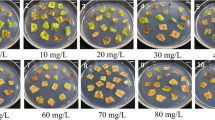Summary
Transgenic herbicide-resistant Scoparia dulcis plants were obtained by using an Ri binary vector system. The chimeric bar gene encoding phosphinothricin acetyltransferase flanked by the promoter for cauliflower mosaic virus 35S RNA and the terminal sequence for nopaline synthase was introduced in the plant genome by Agrobacterium-mediated transformation by means of scratching young plants. Hairy roots resistant to bialaphos were selected and plantlets (R0) were regenerated. Progenies (S1) were obtained by self-fertilization. The transgenic state was confirmed by DNA-blot hybridization and assaying of neomycin phosphotransferase II. Expression of the bar gene in the transgenic R0 and S1 progenies was indicated by the activity of phosphinothricin acetyltransferase. Transgenic plants accumulated scopadulcic acid B, a specific secondary metabolite of S. dulcis, in amounts of 15–60% compared with that in normal plants. The transgenic plants and progenies showed resistant trait towards bialaphos and phosphinothricin. These results suggest that an Ri binary system is one of the useful tools for the transformation of medicinal plants for which a regeneration protocol has not been established.
Similar content being viewed by others
Abbreviations
- CaMV:
-
cauliflower mosaic virus
- NPT-II:
-
neomycin phosphotransferase
- PAT:
-
phosphinothricin acetyltransferase
- PPT:
-
phosphinothricin
References
Asano, S., Mizutani, M., Hayashi, T., Morita, N., and Takeguchi, N. (1990) J. Biol. Chem., 265, 22167–22173
Costantino, P., Spano, L., Pomponi, M., Benvenuto, E., and Ancora, G. (1984) J. Mol. Appl. Genet., 2, 465–470
De Block, M., Botterman, J., Vandewiele, M., Dockx, J., Thoen, C., Gossele, V., Rao Movva, N., Thompson, C, Van Montagu, M., and Leemans, J. (1987) EMBO J., 6, 2513–2518
De Block, M., De Brouwer, D., and Tenning, P. (1989) Plant Physiol., 91, 694–701
Dellaporta, S. L., Wood, J., and Hicks, J. B. (1983) Plant Mol. Biol. Reporter, 1, 19–21
De Paolis, A., Mauro, M. L., Pomponi, M., Cardarelli, M., Spano, L., and Costantino, P. (1985) Plasmid, 13, 1–7
Gamborg, O. L., Miller, R. A., and Ojima, K. (1968) Exp. Cell Res., 50, 151–158
Hamil, J. D., Prescott, A., and Martin, C. (1987) Plant Mol. Biol., 9 573–584
Hayashi, T., Kishi, M., Kawasaki, M., Arisawa, M., Shimizu, M., Suzuki, S., Yoshizaki, M., Morita, N., Tezuka, Y., Kikuchi, T., Berganza, L.H., Ferro, E., and Basualdo, I. (1987) Tetrahedron Lett., 28, 3693–3696
Hayashi, K., Niwayama, S., Hayashi, T., Nago, R., Ochiai, H., and Morita, N. (1988) Antiviral Res., 9, 345–354
Hayashi, T., Okamura, K., Kawasaki, M., and Morita, N. (1991) Phytochem., 30, 3617–3620
Hayashi, K., Hayashi, T., and Morita, N. (1992) Phytother. Res., 6, 6–9
Jouanin, L. (1984) Plasmid, 12, 91–102
Jung, G., and Tepfer, D. (1987) Plant Science, 50, 145–151
Kawasaki, M., Hayashi, T., Arisawa, M., Shimizu, M., Hiroe, S., Ueno H., Syogawa, H., Suzuki, S., Yoshizaki, M., Morita, N., Tezuka, Y., Kikuchi, T., Berganza, LH., Ferro, E., and Basualdo, I. (1987) Chem. Pharm. Bull., 35, 3963–3966
Ko, K. S., Ebizuka, Y., Noguchi, H., Sankawa, U. (1988) Chem. Pharm. Bull., 36, 4217–4220
Lloyd, A. M., Walbot, V., and Davis, R. W. (1992) Science, 258, 1773–1775
Murashige, T., and Skoog, F. (1962) Physiol. Plant, 15, 473–479
Reiss, B., Sprengel, R., Will, H., and Schaller, H. (1984) Gene, 30, 211–218
Saito, K., Kaneko, H., Yamazaki, M., Yoshida, M., and Murakoshi, I. (1990a) Plant Cell Rep., 8, 718–721
Saito, K., Yamazaki, M., Shimomura, K., Yoshimatsu, K., and Murakoshi, I. (1990b) Plant Cell Rep., 9, 121–124
Saito, K., Yamazaki, M., Kaneko, H., Murakoshi, I., Fukuda, Y., and Van Montagu, M. (1991a) Planta, 184, 40–46
Saito, K., Noji, M., Ohmori, S., Imai, Y., and Murakoshi, I. (1991b) Proc. Natl. Acad. Sci. USA, 88, 7041–7045
Saito, K., Yamazaki, M., Kawaguchi, A., and Murakoshi, I. (1991c) Tetrahedron., 47, 5955–5968
Saito, K., Yamazaki, M., and Murakoshi, I. (1992a) J. Nat. Prod., 55, 149–161
Saito, K., Yamazaki, M., Anzai, H., Yoneyama, K., and Murakoshi, I. (1992b) Plant Cell Rep., 11, 219–224
Shahin, E. A., Sukhapinda, K., Simpson, R. B., and Spivey, R. (1986) Theor. Appl. Genet., 72, 770–777
Simpson, R. B., Spielmann, A., Margossian, L., and McKnight, T. D. (1986) Plant Mol. Biol., 6, 403–415
Slightom, J. L., Durand-Tardif, M., Jouanin, L., and Tepfer, D. (1986) J. Biol. Chem., 261, 108–121
Spencer, T. M., Gordon-Kamm, W. J., Daines, R. J., Start, W. G., and Lemaux, P. G. (1990) Theor. Appl. Genet., 79, 625–631
Stougaard, J., Abildsten, D., and Marcker, K. A. (1987) Mol. Gen. Genet., 207, 251–255
Sukhapinda, K., Spivey, R., Simpson, R. B., and Shahin, E. A. (1987) Mol. Gen. Genet., 206, 491–497
Tepfer, D. (1984) Cell, 37, 959–967
Tepfer, D., Metzger, L., and Prost, R. (1989) Plant Mol. Biol., 13, 295–302
Author information
Authors and Affiliations
Additional information
Communicated by K. Shimamoto
Rights and permissions
About this article
Cite this article
Yamazaki, M., Son, L., Hayashi, T. et al. Transgenic fertile Scoparia dulcis L., a folk medicinal plant, conferred with a herbicide-resistant trait using an Ri binary vector. Plant Cell Reports 15, 317–321 (1996). https://doi.org/10.1007/BF00232363
Received:
Revised:
Issue Date:
DOI: https://doi.org/10.1007/BF00232363




